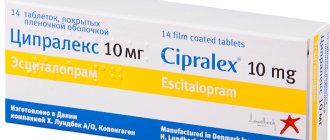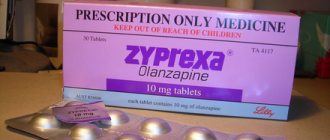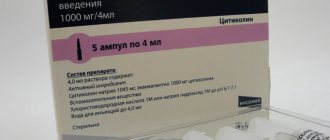Pharmacokinetics
Suction
After oral administration, fluvoxamine is completely absorbed from the gastrointestinal tract. Cmax in blood plasma is achieved after 3-8 hours. Absolute bioavailability is 53% after primary metabolism in the liver. Concomitant use of fluvoxamine with food does not affect pharmacokinetics.
Distribution
The degree of binding to plasma proteins is about 80% (in vitro). Vd - 25 l/kg. Css in blood plasma is usually achieved after 10-14 days.
The pharmacokinetics of fluvoxamine after a single dose is linear. Css concentration of fluvoxamine is higher than the concentration after a single dose, and this disproportionality is more pronounced at higher daily doses.
Metabolism
Fluvoxamine is biotransformed in the liver (mainly by oxidative demethylation) to at least 9 metabolites. Two main metabolites have little pharmacological activity, the rest are pharmacologically inactive.
Fluvoxamine significantly inhibits the isoenzymes of cytochrome P450 (CYP) 1A2 and 2C19, and moderately inhibits the isoenzymes CYP2C9, 3A4 and 2D6.
Although the 2D6 isoenzyme of cytochrome P450 is the main one in the metabolism of fluvoxamine, the concentration of the drug in the blood plasma in individuals with reduced function of this isoenzyme is not much higher than in individuals with normal metabolism.
Removal
After taking a single dose, the average T1/2 from blood plasma is 13-15 hours; with multiple doses, T1/2 increases slightly and is 17-22 hours.
Fluvoxamine is excreted in the urine in the form of metabolites.
Pharmacokinetics in special clinical situations
The pharmacokinetics of fluvoxamine are similar in healthy people, the elderly and patients with renal failure.
The metabolism of fluvoxamine is reduced in patients with liver disease.
Fluvoxamine plasma Css were twice as high in children (aged 6–11 years) than in adolescents (aged 12–17 years). Concentrations of the drug in the blood plasma of adolescents are similar to those in adults.
Contraindications
- simultaneous use with tizanidine and MAO inhibitors (treatment with fluvoxamine can be started 2 weeks after stopping taking an irreversible MAO inhibitor, the day after stopping taking a reversible MAO inhibitor (for example, moclobemide, linezolid). The time interval between stopping fluvoxamine and starting therapy any MAO inhibitor should be at least 1 week
- simultaneous use with ramelteon
- hypersensitivity to the active substance or to any of the components of the drug.
The drug should be prescribed with caution in case of liver and kidney failure, a history of seizures, epilepsy, patients with a tendency to bleeding (thrombocytopenia), pregnancy, lactation, and elderly patients.
Fevarin during pregnancy and breastfeeding
Epidemiological data suggest that the use of selective serotonin reuptake inhibitors (SSRIs) during pregnancy, especially in the last months of pregnancy, may increase the risk of persistent pulmonary hypertension (PPH) in the newborn. Available data indicate that PLH occurs in approximately 5 cases per 1000 births (as opposed to 1-2 cases per 1000 births if the mother did not use SSRIs in late pregnancy).
The use of fluvoxamine during pregnancy is not recommended, unless the woman's clinical condition indicates the need for its use.
Isolated cases of withdrawal syndrome in newborns have been described following the use of fluvoxamine at the end of pregnancy.
Some newborns after exposure to SSRIs in the third trimester of pregnancy experienced feeding and/or breathing difficulties, convulsive disorders, unstable body temperature, hypoglycemia, tremors, muscle tone disorders, increased neuro-reflex excitability syndrome, cyanosis, irritability, lethargy, drowsiness, nausea, difficulty falling asleep and continuous crying, which may require longer hospitalization.
Fluvoxamine passes into breast milk in small quantities. In this regard, the drug should not be used during lactation.
Fluvoxamine should not be prescribed to patients who are planning pregnancy, unless the patient's clinical condition requires the use of fluvoxamine.
Experimental reproductive toxicity studies in animals have shown that fluvoxamine affects the reproductive function of males and females, increases the risk of intrauterine fetal death and reduces fetal body weight in doses exceeding the maximum recommended dose for humans by approximately 4 times. In addition, an increased incidence of perinatal mortality in puppies was observed in pre- and postnatal studies. The significance of these data for humans is unknown.
Fevarin: instructions for use
Fluvoxamine tablets should be taken orally, without chewing, with water. The tablet can be divided into 2 equal parts.
Depression
The recommended starting dose for adults is 50 mg or 100 mg 1 time / day, in the evening. It is recommended to gradually increase the dose to the effective level. The effective daily dose, usually 100 mg, is selected individually depending on the patient's response to treatment. The daily dose can reach 300 mg. Daily doses above 150 mg should be divided into several doses.
According to official WHO recommendations, antidepressant treatment should be continued for at least 6 months of remission after a depressive episode.
To prevent relapses of depression, Fevarin is recommended to be prescribed at a dose of 100 mg 1 time/day daily.
Due to the lack of clinical experience, Fevarin is not recommended for the treatment of depression in children under 18 years of age.
Obsessive-compulsive disorders (OCD)
The recommended starting dose for adults is 50 mg/day for 3-4 days. The effective daily dose is usually from 100 to 300 mg. Doses should be increased gradually until an effective daily dose is reached, which should not exceed 300 mg in adults. Doses up to 150 mg can be taken once daily, preferably in the evening. Daily doses above 150 mg are recommended to be divided into 2 or 3 doses.
The initial dose for children over 8 years of age and adolescents is 25 mg/day for 1 dose. Maintenance dose - 50-200 mg/day. The maximum daily dose is 200 mg. Doses of more than 100 mg/day are recommended to be divided into 2 or 3 doses.
With a good therapeutic response, treatment can be continued with an individually selected daily dose. If improvement is not achieved after 10 weeks of taking the drug, treatment with fluvoxamine should be reconsidered. So far, no systematic studies have been organized that could answer the question of how long treatment with fluvoxamine can be carried out, however, obsessive-compulsive disorders are chronic in nature, it can be considered advisable to extend the course of treatment with Fevarin for more than 10 weeks in patients with adequate therapeutic effect. The selection of the minimum effective maintenance dose should be done individually and with caution. The need for treatment needs to be re-evaluated periodically. Some clinicians recommend concomitant psychotherapy in patients with a good effect of pharmacotherapy.
Fevarin
Name:
Fevarin
Dosage form, composition and pack
The tablets are white, round, biconvex, film-coated, scored and engraved with “291” on both sides of the score on one side of the tablet and the letter “S” above the V- on the other side.
1 tab. — fluvoxamine maleate — 50 mg.
Excipients: mannitol (152 mg), corn starch, pregelatinized starch, sodium stearyl fumarate, colloidal silicon dioxide. Composition of the tablet shell: hypromellose, macrogol 6000, talc, titanium dioxide (E171).
The tablets are white, oval, biconvex, film-coated, scored and engraved with “313” on both sides of the score on one side of the tablet and the letter “S” above the V- on the other side.
1 tab. — fluvoxamine maleate — 100 mg.
Excipients: mannitol (303 mg), corn starch, pregelatinized starch, sodium stearyl fumarate, colloidal silicon dioxide. Composition of the tablet shell: hypromellose, macrogol 6000, talc, titanium dioxide (E171).
pharmachologic effect
Antidepressant. The mechanism of action is associated with selective inhibition of serotonin reuptake by brain neurons and is characterized by minimal effects on noradrenergic transmission. Fevarin has a weak ability to bind to alpha and beta adrenergic receptors, histamine, m-cholinergic receptors, dopamine and serotonin receptors.
Pharmacokinetics
Suction
After oral administration, Fevarin is completely absorbed from the gastrointestinal tract. Cmax in blood plasma is achieved after 3-8 hours. Absolute bioavailability is 53% as a result of primary metabolism in the liver. Concomitant use of the product with food does not affect the pharmacokinetics of fluvoxamine. Distribution The degree of binding to plasma proteins is within 80%. Metabolism Fluvoxamine is biotransformed in the liver (mainly by oxidative demethylation) to at least 9 metabolites. Two main metabolites have non-core pharmacological activity, the rest are pharmacologically inactive.
Removal
After taking a single dose, the average T1/2 from blood plasma is 13-15 hours; with multiple doses, T1/2 increases slightly and is 17-22 hours. Fluvoxamine is excreted in the urine in the form of metabolites.
Pharmacokinetics in special clinical cases.
The pharmacokinetics of fluvoxamine is the same in healthy people, the elderly and patients with renal failure. The metabolism of fluvoxamine is reduced in patients with liver disease.
Steady-state fluvoxamine plasma concentrations were twice as high in children (ages 6–11 years) than in adolescents (ages 12–17 years). Concentrations of the product in the blood plasma of adolescents are similar to those in adults.
Indications
- depression of various origins;
- obsessive-compulsive disorders.
Dosage regimen
When treating depression, the recommended initial dose is 50 mg or 100 mg 1 time / day, in the evening. The dose should be increased gradually. The effective dose, usually 100 mg/day, is selected individually depending on the patient's response to treatment. The daily dose can reach 300 mg.
Doses of more than 150 mg/day should be divided into several doses.
According to official WHO recommendations, treatment with antidepressants should be continued for at least 6 months after the depressive episode has resolved.
To prevent relapses of depression, Fevarin is recommended to be prescribed at a dose of 100 mg 1 time / day. When treating obsessive-compulsive disorders, the recommended initial dose is 50 mg/day for 3-4 days. The dose should be increased gradually until an effective daily dose is reached, which is usually 100-300 mg. The maximum effective dose for adults is 300 mg/day. Doses up to 150 mg can be taken 1 time/day, preferably in the evening. Doses of more than 150 mg/day are recommended to be divided into 2 or 3 doses.
For children over 8 years of age and adolescents, the initial dose is 25 mg/day for 1 dose. Maintenance dose - 50-200 mg/day. The maximum daily dose is 200 mg. Doses of more than 100 mg/day are recommended to be divided into 2 or 3 doses.
If an adequate therapeutic effect develops, treatment can be continued with an individually selected daily dose. If improvement is not achieved after 10 weeks of treatment, Fevarin should be discontinued. Considering that obsessive-compulsive disorders are chronic, it can be considered advisable to extend the course of treatment with Fevarin for more than 10 weeks in patients with an adequate therapeutic effect. The selection of the minimum effective maintenance dose should be carried out individually and with caution. Some clinicians recommend concomitant psychotherapy in patients with a good effect of pharmacotherapy.
In case of liver or kidney failure, treatment should begin with the lowest dose under the strict supervision of a physician. Fevarin tablets should be taken without chewing and with a small amount of water.
Side effect
The most commonly observed symptom associated with the use of Fevarin is nausea, sometimes accompanied by vomiting. This side effect usually disappears within the first two weeks of treatment.
Some side effects observed in clinical trials were often related to symptoms of depression rather than to treatment with Fevarin.
From the digestive system: often (1-10%) - abdominal pain, anorexia, constipation, diarrhea, dry mouth, dyspepsia; not often (<0.1%) - impaired liver function (increased levels of liver transaminases).
From the central nervous system and peripheral nervous system: often (1-10%) - asthenia, headache, malaise, nervousness, anxiety, agitation, dizziness, insomnia or drowsiness, tremor; sometimes (<1%) - ataxia, confusion, extrapyramidal disorders, hallucinations; not often (<0.1%) - convulsions, manic syndrome, serotonergic syndrome (a condition similar to neuroleptic malignant syndrome, hyponatremia and syndrome of insufficient secretion of antidiuretic hormone); very rarely - paresthesia, taste perversion.
From the cardiovascular system: often (1-10%) - palpitations, tachycardia; sometimes (<1%) - postural hypotension.
Dermatological reactions: often (1-10%) - increased sweating; not often (<0.1%) - photosensitivity.
Allergic reactions: sometimes (<1%) - rash, itching, angioedema.
From the musculoskeletal system: sometimes (<1%) - arthralgia, myalgia.
From the reproductive system: sometimes (<1%) - delayed ejaculation; not often (<0.1%) - galactorrhea; very rarely - anorgasmia.
From the blood coagulation system: ecchymosis, purpura, gastrointestinal bleeding.
Other: uncommon (<0.1%) - changes in body weight. When you stop taking Fevarin fluvoxamine, withdrawal symptoms may develop, although preclinical and clinical studies have not shown dependence on fluvoxamine treatment.
Symptoms observed in case of discontinuation of the product: dizziness, paresthesia, headache, nausea, anxiety. Most of these symptoms are mild and self-limiting. When discontinuing the product, a gradual dose reduction is recommended.
Contraindications
- simultaneous use with tizanidine;
- simultaneous use with MAO inhibitors;
- high sensitivity to fluvoxamine maleate or other components of the product.
The product should be prescribed with caution in case of liver and kidney failure, a history of seizures, epilepsy, patients with a tendency to bleeding (thrombocytopenia), pregnancy, and elderly patients.
Pregnancy and lactation
Data from a small number of observations did not reveal any adverse effects of fluvoxamine on pregnancy. Potential risk unknown. The drug should be prescribed during pregnancy with caution. Isolated cases of withdrawal syndrome in newborns have been described following the use of fluvoxamine at the end of pregnancy. Fluvoxamine is excreted in small amounts in breast milk. In this regard, the product should not be used during lactation.
special instructions
With depression, there is usually a high likelihood of attempting suicide, which may persist until sufficient remission is achieved.
Such patients should be monitored.
Patients with hepatic or renal insufficiency at the beginning of treatment should be prescribed Fevarin in the minimum effective doses under the strict supervision of a physician. In rare cases, treatment with Fevarin may lead to an increase in the level of liver transaminases, most often accompanied by corresponding clinical symptoms. In such cases, Fevarin should be discontinued.
Control of blood glucose levels may be impaired, especially in the early stages of treatment with Fevarin, and therefore dose adjustment of hypoglycemic products may be required.
Prescribe with caution to patients with a history of seizures. Fevarin should be avoided in patients with unstable epilepsy, and patients with stable epilepsy should be under strict medical supervision. Treatment with Fevarin should be discontinued if epileptic seizures occur or their frequency increases.
Rare cases of the development of serotonergic syndrome or a condition similar to neuroleptic malignant syndrome have been described, which may be associated with taking fluvoxamine in combination with other serotonergic antidepressants and antipsychotic drugs. Because these syndromes can lead to potentially life-threatening conditions manifested by hyperthermia, muscle rigidity, myoclonus, autonomic nervous system lability with possible rapid changes in vital signs, mental changes including increased irritability, agitation, confusion, delirium and coma - treatment with Fevarin should be discontinued. If necessary, appropriate symptomatic treatment should be carried out.
As with the use of other selective serotonin reuptake inhibitors, in rare cases, while taking Fevarin, hyponatremia may occur, which reverses after discontinuation of the product. Some cases were caused by the syndrome of insufficient secretion of antidiuretic hormone, which was observed mainly in elderly patients.
There are reports of the development of ecchymosis and purpura, as well as hemorrhagic manifestations (for example, gastrointestinal bleeding) when using selective serotonin reuptake inhibitors. Given this, such drugs should be prescribed with caution, especially concomitantly with products that affect platelet function (for example, with atypical antipsychotics and phenothiazines, many tricyclic antidepressants, NSAIDs, including acetylsalicylic acid), also in patients with a history of bleeding and prone to bleeding (for example, patients with thrombocytopenia). Data obtained from the treatment of elderly and younger patients indicate that there are no clinically significant differences in the effectiveness of the product used in usual daily doses. However, in elderly patients, the dose of the product should always be increased more slowly and with greater caution.
Fevarin can lead to a slight decrease in heart rate (by 2-6 beats/min). As with the use of other psychotropic products, alcohol consumption is not recommended during treatment with Fevarin.
Use in pediatrics
Due to the lack of clinical experience, Fevarin is not recommended for the treatment of depression in children.
Impact on the ability to drive vehicles and operate machinery
Fevarin in doses up to 150 mg when administered to healthy volunteers did not affect psychomotor functions associated with driving a car or operating machines and mechanisms. At the same time, there are reports of drowsiness observed during the use of the product. Therefore, caution is recommended until the individual response to treatment is definitively determined.
Overdose
Symptoms: the most common are nausea, vomiting, diarrhea, drowsiness, dizziness. There are reports of cardiac dysfunction (tachycardia, bradycardia, arterial hypotension), liver dysfunction, convulsions, coma.
Fluvoxamine has a wide therapeutic dose range. To date, deaths associated with fluvoxamine overdose have been extremely rare. The highest recorded dose taken by one patient was 12 g (the patient was cured as a result of symptomatic therapy). More serious complications were observed in cases of deliberate overdose of Fevarin against the background of concomitant pharmacotherapy.
Treatment: gastric lavage, which should be carried out as soon as possible after taking the product; carry out symptomatic therapy. In addition, it is recommended to take activated carbon multiple times and, if necessary, prescribe osmotic laxatives. There is no specific antidote. Forced diuresis or dialysis is not advisable.
Drug interactions
Fevarin should not be used in combination with MAO inhibitors. Treatment with Fevarin can be started 2 weeks after stopping the irreversible MAO inhibitor; the next day after stopping the reversible MAO inhibitor; the time interval between stopping Fevarin and starting therapy with any MAO inhibitor should be at least 1 week.
When combined with Fevarin, plasma concentrations of terfenadine, astemizole or cisapride may increase, increasing the risk of QT prolongation. Therefore, Fevarin should not be prescribed simultaneously with these products. Drugs that are significantly metabolized by these isoenzymes are eliminated more slowly and may have higher plasma concentrations when used simultaneously with Fevarin. This is especially important for products that have a narrow therapeutic effect. Patients require careful monitoring, and dosage adjustments of these products are recommended if necessary. With simultaneous use of Fevarin, an increase in previously stable levels of tricyclic antidepressants (clomipramine, imipramine, amitriptyline) and antipsychotics (clozapine, olanzapine), which are significantly metabolized by cytochrome P450IA2, was observed. Therefore, a dose reduction of these products may be recommended.
Patients simultaneously taking Fevarin and products with a narrow therapeutic index metabolized by cytochrome P450 1A2 (tacrine, theophylline, methadone, mexiletine), metabolized by cytochrome P450 2C (phenytoin) and metabolized by cytochrome P450ZA4 (carbamazepine, cyclosporine) should be under close medical supervision .
If necessary, it is recommended to adjust the doses of these products.
When Fevarin was used in combination with warfarin, a significant increase in plasma warfarin concentrations and prolongation of prothrombin time were observed.
Isolated cases of cardiotoxicity have been reported with concomitant use of Fevarin and thioridazine.
In studies examining the interactions of Fevarin, an increase in propranolol concentrations was noted following the administration of Fevarin. In this regard, it is possible to recommend reducing the dose of propranolol in case of simultaneous use with Fevarin.
Plasma caffeine levels may increase while taking Fevarin. Therefore, patients who consume large amounts of caffeine-containing beverages should reduce their consumption while taking Fevarin and when adverse effects of caffeine, such as tremor, palpitations, nausea, restlessness, and insomnia, are observed.
When taking Fevarin and ropinirole simultaneously, the plasma concentration of ropinirole may increase, thereby increasing the risk of overdose. In such cases, it is recommended to control, or, if necessary, reduce the dosage of ropinirole during treatment with Fevarin. When administered concomitantly with fluvoxamine, anxiolytics from the group of benzodiazepines that undergo oxidative metabolism, such as triazolam, midazolam, alprazolam and diazepam, may increase their plasma concentrations. The dosage of these products should be reduced while taking Fevarin.
Fluvoxamine has no effect on plasma concentrations of digoxin and atenolol.
In the case of combined use of Fevarin with serotonergic products (triptans, serotonin reuptake inhibitors), tramadol, the serotonergic effects of fluvoxamine may be enhanced.
Fevarin has been used in combination with lithium products to treat severely ill patients who respond poorly to pharmacotherapy. It should be noted that lithium (and possibly also tryptophan) enhances the serotonergic effects of Fevarin, and therefore this kind of combination pharmacotherapy must be carried out with caution.
When taking oral anticoagulants and fluvoxamine simultaneously, the risk of hemorrhage may increase. Such patients should be under medical supervision.
Storage conditions and periods
List B. The drug should be stored in a dry place, protected from light, out of reach of children, at a temperature not exceeding 25°C.
Shelf life: 3 years (if stored in an undamaged original package).
Attention! Before using Fevarin, you should consult your doctor. The instructions are provided solely for familiarization with “ Fevarin ”.
Side effects
Some side effects observed in clinical trials were often related to the disease and not to treatment with Fevarin. All reactions are distributed according to organ systems and frequency of development: often (>1% and 0.1% and 0.01% and
From the blood coagulation system: frequency unknown - bleeding (for example, gastrointestinal bleeding, gynecological bleeding, ecchymosis, purpura).
From the endocrine system: frequency unknown - hyperprolactinemia, syndrome of inadequate production of ADH.
Metabolism and nutrition: often - anorexia, frequency unknown - hyponatremia, weight loss, weight gain.
From the mental point of view: infrequently - hallucinations, a state of confused consciousness; rarely - mania; frequency unknown - suicidal thinking, suicidal behavior.
From the nervous system: often - anxiety, increased excitability, restlessness, insomnia, drowsiness, tremor, headache, dizziness infrequently - extrapyramidal disorders, ataxia rare - convulsions frequency unknown - serotonin syndrome, NMS, akathisia/psychomotor agitation, paresthesia, dysgeusia.
From the organ of vision: frequency unknown - glaucoma, mydriasis.
From the cardiovascular system: often - palpitations, tachycardia, infrequently - orthostatic hypotension.
From the digestive system: often - abdominal pain, constipation, diarrhea, dry mouth, dyspepsia, nausea, vomiting; rarely - impaired liver function (increased activity of liver enzymes).
From the skin and subcutaneous tissues: often - increased sweating; infrequently - skin hypersensitivity reactions (including rash, itching, angioedema); rarely - photosensitivity reactions.
From the musculoskeletal system: infrequently - arthralgia, myalgia; frequency unknown - bone fractures.*
From the urinary system: frequency unknown - urinary disorders (including urinary retention, urinary incontinence, pollakiuria, nocturia and enuresis).
From the reproductive system: infrequently - disturbance (delay) of ejaculation; rarely - galactorrhea; frequency unknown - anorgasmia, menstrual irregularities (such as amenorrhea, hypomenorrhea, metrorrhagia, menorrhagia).
General disorders: often - asthenia, malaise; frequency unknown - drug withdrawal syndrome, including withdrawal syndrome in newborns whose mothers took fluvoxamine in late pregnancy.
* - epidemiological studies performed primarily on patients aged 50 years and older have shown an increased risk of bone fractures in patients receiving SSRIs and tricyclic antidepressants. The mechanism by which this risk increases is unknown.
Withdrawal syndrome after discontinuation of fluvoxamine
Stopping the use of fluvoxamine (especially abruptly) often leads to the development of withdrawal syndrome. For this reason, if treatment with fluvoxamine is no longer required, it is recommended to gradually reduce the dose until the drug is completely discontinued.
How to use the drug
Fevarin's instructions warn against chewing and sucking the tablets. The antidepressant Fevarin is taken according to the doctor’s recommendations, swallowing and without chewing the tablet, washing it down with plenty of water.
Depression in adults
How to take Fevarin at the beginning of treatment is determined by the attending physician. It is recommended to take it before bedtime. At the discretion of the attending physician, the dosage can be gradually increased until the desired therapeutic effect is achieved.
The dosage is selected carefully, taking into account the individual reaction of the body. The daily dosage should not exceed 0.3 g. If dosages of more than 0.15 g are prescribed, they must be divided into several doses.
When the signs of depression disappear, it is necessary to continue taking the drug for another six months in maintenance dosages to prevent relapse of depression.
OCD in adults
Fevarin and Triftazin for OCD are prescribed by the attending physician. Begin treatment with small dosages and observe the body’s reaction. After four days, the dosage is gradually increased until the maximum effective dosage is found.
Dosages per day up to 0.15 g are taken in one dose in the evening, dosages over 0.15 g are divided into several doses.
If the desired therapeutic result is not achieved within three months, the advisability of treatment with Fevarin should be reconsidered. Given the chronic nature of OCD in adults, treatment can be continued longer. The advisability of continuing treatment should be reviewed from time to time by the attending physician.
Patients who experience a therapeutic effect should additionally undergo behavioral psychotherapy.
Children from eight years old
The initial dosage should be half that for adults. It is advisable to take the drug before bedtime. It is allowed to gradually increase the dosage once a week until the desired result is achieved.
The maximum dosage for children per day should not be more than 0.2 g. If the daily dosage of 50 mg is exceeded, it is divided into two or three doses. If, when dividing the tablet, one part turns out to be larger, you should drink it before bed.
Treatment with Fevarin in childhood is allowed only for OCD; for all other mental diseases, the drug is contraindicated until the age of 18.
When used to treat depression, paradoxical reactions such as anger, aggressiveness, and suicidal thoughts were observed. Therefore, the drug should be prescribed to a child with OCD only after an accurate diagnosis has been established.
Overdose
An overdose of Fevarin manifests itself in symptoms such as nausea, vomiting, stool disturbances, fainting, lethargy and drowsiness. Cardiovascular symptoms reported: tachycardia, hypotension, bradycardia. Possible disturbances in liver function and convulsions. In severe cases, coma may develop.
Reports of deaths are extremely rare. There have been cases recorded with a maximum dosage of 12 g per day, in which patients fully recovered with timely assistance.
If the dosage of the drug is deliberately exceeded, more serious consequences are possible.
The drug does not have a specific antidote. In case of overdose, gastric lavage is done as quickly as possible and treated symptomatically. It is recommended to take activated carbon.
Adverse reactions
Side effects of Fevarin are similar to symptoms of depression, so it is quite difficult to differentiate them from each other.
From the hormonal system, abnormal secretion of the hormone vasopressin is possible. From the metabolic side, a reaction such as loss of appetite is often observed, and rarely an increase or decrease in body weight.
Occasionally, reactions to Fevarin such as hallucinations, confusion, aggressiveness, and even more rarely, the occurrence of mania were observed. When used contrary to contraindications, suicidal thoughts and behavior may develop.
The central nervous system may respond to the drug with agitation, nervousness, anxiety, insomnia, or drowsiness. Headaches and dizziness, hand tremors are possible. If recommendations for drug interactions are violated, serotonin syndrome, which is dangerous to health, may develop.
The cardiovascular system may respond to treatment with Fevarin with an accelerated heartbeat, decreased blood pressure, and tachycardia. Gastrointestinal disorders included abdominal pain, constipation, dry mouth, nausea, and vomiting.
The patient may experience increased sweating, and sometimes arthralgia and myalgia develop. The reproductive system may react with late ejaculation in men and galactorrhea.
Drug interactions
Some patients are prescribed a combination of Fevarin and Triftazin to eliminate panic attacks. The correct treatment regimen should involve small concentrations of Triftazine and standard Fevarin.
Doctors speak well of the combination of Seroquel and Fevarin, but only for the treatment of depression in adults. The regimen can be supplemented with Phenazepam and Fevarin, but the dosage of the latter in this case must be individually calculated and selected by the attending physician.
Information on interactions with MAO inhibitors is given in contraindications.
Effect on the metabolism of other drugs
Fevarin can slow down or completely stop the absorption of drugs that are metabolized by the liver to a greater extent, therefore, before prescribing them, a mandatory consultation with your doctor is necessary. Drugs that are metabolized by the liver may be less cleared, which means their concentrations in the blood will be higher.
Carbamazepine, Theophylline, Methadone
Careful monitoring of patients taking these drugs simultaneously with Fevarin, as well as Tacrine, Mexiletine, Phenytoin, Cyclosporine is necessary. Their dosages need to be adjusted.
Neuroleptics, tricyclic antidepressants
Concentrations of tricyclic antidepressants may increase simultaneously with the drug Fevarin, therefore, when combining these drugs, the dosage of tricyclic antidepressants should be reduced.
Ethanol
It is recommended to avoid the combination of Fevarin and alcohol, as well as medications containing alcohol. The effects of Fevarin and alcohol in combination can be unpredictable and lead to immediate adverse reactions.
special instructions
As with the use of other psychotropic drugs, it is not recommended to consume alcohol during treatment with Fevarin.
Depression is associated with an increased risk of suicidal ideation, self-harm, and suicide attempts (suicidal behavior). This risk persists until the condition significantly improves. Since improvement may not occur within the first few weeks of treatment or longer, patients should be closely monitored until such improvement occurs.
Increased risk of suicide in the early stages of recovery is widespread in clinical practice.
Other psychiatric disorders for which fluvoxamine is prescribed may also be associated with an increased risk of suicidal behavior. In addition, these conditions may accompany major depression. Therefore, patients with other mental disorders should be closely monitored.
Patients with a history of suicidal behavior or a significant degree of suicidal ideation are known to be at greater risk of suicidal ideation or suicide attempts before treatment and should be closely monitored during treatment.
Careful monitoring of patients, especially those at high risk, should accompany drug therapy, especially in its early stages and after dose changes.
Patients (and their caregivers) should be warned to monitor for any clinical deterioration, suicidal behavior or thoughts, or unusual changes in behavior, and to immediately seek professional advice if such symptoms occur.
The development of akathisia associated with fluvoxamine is characterized by subjectively unpleasant and painful anxiety. The need to move was often accompanied by an inability to sit or stand still. The development of this condition is most likely during the first few weeks of treatment. Increasing the dose of the drug in patients with such symptoms may worsen their condition.
Caution should be exercised when prescribing the drug to patients with a history of seizures. Fluvoxamine should be avoided in patients with unstable epilepsy, and patients with stable epilepsy should be closely monitored. Treatment with Fevarin should be discontinued if epileptic seizures occur or their frequency increases.
Rare cases of serotonergic syndrome or NMS-like conditions have been described and may be associated with fluvoxamine, especially in combination with other serotonergic and/or antipsychotic drugs. These syndromes can lead to potentially life-threatening conditions manifested by hyperthermia, muscle rigidity, myoclonus, autonomic nervous system lability with possible rapid changes in vital parameters (including pulse, respiration, blood pressure), mental status changes including confusion, irritability, extreme agitation, reaching delirium or coma. Therefore, in such cases, Fevarin should be discontinued and appropriate symptomatic treatment should be started.
As with the use of other selective serotonin reuptake inhibitors, in rare cases hyponatremia may occur, which reverses after discontinuation of fluvoxamine. Some cases have been caused by ADH deficiency syndrome. These cases were mainly observed in elderly patients.
Blood glucose control may be impaired (ie, hyperglycemia, hypoglycemia, impaired glucose tolerance), especially early in treatment. If Fevarin is prescribed to patients with a history of diabetes mellitus, dose adjustment of hypoglycemic drugs may be required.
The most commonly observed symptom associated with the use of Fevarin is nausea, sometimes accompanied by vomiting. This side effect usually disappears within the first 2 weeks of treatment.
Cases of mydriasis have been reported with the use of SSRIs such as fluvoxamine. Therefore, patients with elevated intraocular pressure or patients at increased risk of acute angle-closure glaucoma should be prescribed fluvoxamine with caution.
There are reports of intradermal hemorrhages such as ecchymosis and purpura, as well as other hemorrhagic manifestations (for example, gastrointestinal bleeding or gynecological bleeding), observed with the use of selective serotonin reuptake inhibitors. Caution should be exercised when prescribing these drugs in elderly patients and patients concomitantly receiving drugs that affect platelet function (for example, atypical antipsychotics and phenothiazines, many tricyclic antidepressants, acetylsalicylic acid, NSAIDs) or drugs that increase the risk of bleeding, as well as in patients with a history of bleeding or prone to bleeding (for example, thrombocytopenia or coagulation disorders).
Increased risk of prolongation of the QT interval/paroxysmal ventricular tachycardia of the "pirouette" type during combination therapy with fluvoxamine with terfenadine or astemizole or cisapride, due to an increase in the concentration of the latter in the blood plasma. Therefore, fluvoxamine should not be coadministered with these drugs.
Fluvoxamine may cause a slight decrease in heart rate (by 2-6 beats/min).
There is limited clinical experience with the use of fluvoxamine in conjunction with ECT, so such therapy should be carried out with caution.
When you stop taking fluvoxamine, withdrawal syndrome may develop, although available data from preclinical and clinical studies have not revealed the occurrence of dependence on fluvoxamine treatment. The most common symptoms noted in case of drug withdrawal: dizziness, sensory disturbances (including paresthesia, visual disturbances and electric shock sensations), sleep disturbances (including insomnia and vivid dreams), agitation, irritability, confusion, emotional lability, headache, nausea and /or vomiting, diarrhea, sweating, palpitations, tremors and anxiety. Most of these symptoms are mild or moderate and self-limiting, but in some patients they can be severe and/or prolonged. These symptoms usually occur within the first few days after stopping treatment. For this reason, it is recommended to gradually reduce the dose of fluvoxamine before complete discontinuation according to the patient's condition.
Fluvoxamine should be used with caution in patients with a history of mania/hypomania. If the patient develops a manic phase, fluvoxamine should be discontinued.
Treatment of patients with liver or kidney failure should begin with the drug in a low dose; such patients require strict medical supervision. In rare cases, treatment with fluvoxamine may lead to an increase in the activity of liver enzymes, which is most often accompanied by corresponding clinical symptoms; in such cases, Fevarin should be discontinued.
Data obtained from the treatment of elderly patients and younger patients indicate that there are no clinically significant differences between the daily doses usually used in them. However, dose increases in elderly patients should always be done more slowly and with greater caution.
A meta-analysis of placebo-controlled clinical trials of antidepressants in adult patients with mental disorders found an increased risk of suicidal behavior with antidepressants compared with placebo in patients younger than 25 years. When prescribing fluvoxamine, the risk of suicide should be weighed against the benefits of its use.
Side effects of the drug Fevarin
Nausea and vomiting are the most common symptoms associated with treatment with Fevarin. The severity of this side effect decreases significantly during the first two weeks of treatment. Other adverse events observed during clinical trials at the frequencies listed below were often disease-related and not necessarily related to treatment. Often (frequency 1–10%) Metabolic and nutritional disorders: anorexia. From the central nervous system: agitation, anxiety, dizziness, headache, insomnia, nervousness, drowsiness, tremor. From the cardiovascular system: palpitations/tachycardia. From the gastrointestinal tract: abdominal pain, constipation, diarrhea, dry mouth, dyspepsia. From the skin and subcutaneous tissues: increased sweating. General disorders and reactions at the injection site: asthenia, feeling of malaise. Uncommon (frequency ≤ 1%) Mental disorders: confusion, hallucinations. From the central nervous system: ataxia, extrapyramidal symptoms. From the cardiovascular system: (postural) hypotension. From the skin and subcutaneous tissues: rash, itching, angioedema. From the musculoskeletal system: arthralgia, myalgia. From the reproductive system: disturbance (delay) of ejaculation. Rarely (frequency ≤ 0.1%) Mental disorders: manic states. From the side of the central nervous system: convulsions. From the hepatobiliary system: impaired liver function. From the skin and subcutaneous tissues: photosensitivity. From the reproductive system and mammary glands: galactorrhea. Other side effects that were observed during use of the drug. Cases of weight gain or loss have been recorded, as well as serotonin syndrome, phenomena similar to neuroleptic malignant syndrome, hyponatremia and syndrome of impaired antidiuretic hormone secretion (see also section “Peculiarities of use”). After discontinuation of treatment with Fevarin, a withdrawal reaction may occur, although preclinical and clinical data do not indicate that this treatment is addictive. In connection with drug withdrawal, the following symptoms were observed: dizziness, paresthesia, headache, nausea and anxiety. They usually disappear on their own. Before stopping treatment, it is advisable to consider the need to gradually reduce the dose of the drug. Hemorrhagic manifestations: ecchymosis, purpura, gastrointestinal bleeding (see also section “Peculiarities of use”). Paresthesia, anorgasmia and changes in taste sensations occurred very rarely. In each frequency group, undesirable effects are arranged according to the degree of reduction in their severity.
Compatibility with other drugs
Fluvoxamine should not be used in combination with MAO inhibitors, including linezolid, due to the risk of developing serotonin syndrome.
Fluvoxamine may inhibit the metabolism of drugs that are metabolized by certain cytochrome P450 isoenzymes. In vitro and in vivo studies have shown a powerful inhibitory effect of fluvoxamine on cytochrome P450 isoenzymes 1A2 and 2C19 and, to a lesser extent, on cytochrome P450 isoenzymes 2C9, 2D6 and 3A4.
Drugs that are significantly metabolized by these isoenzymes are eliminated more slowly and may have higher plasma concentrations when used concomitantly with fluvoxamine. Such drugs should be prescribed at a minimum dose or the dose should be reduced to a minimum when used simultaneously with fluvoxamine. Close monitoring of plasma concentrations, effects or side effects is required, and dosage adjustments of these drugs are required if necessary. This is especially important for drugs that have a narrow therapeutic index.
When taking Fevarin 100 mg 2 times a day for 3 days before simultaneous use of ramelteon at a dose of 16 mg, the AUC value for ramelteon increased approximately 190 times, and the Cmax value increased approximately 70 times compared to these parameters when prescribing one ramelteon.
Patients concomitantly taking fluvoxamine and drugs with a narrow therapeutic index that are metabolized exclusively or by a combination of cytochrome P450 isoenzymes that inhibit fluvoxamine (such as tacrine, theophylline, methadone, mexiletine, phenytoin, carbamazepine, and cyclosporine) should be closely monitored. If necessary, dose adjustment of these drugs is recommended.
With simultaneous use of fluvoxamine, an increase in the concentration of tricyclic antidepressants (for example, clomipramine, imipramine, amitriptyline) and antipsychotics (for example, clozapine, olanzapine, quetiapine), which are significantly metabolized by the cytochrome P450 1A2 isoenzyme, was observed. Therefore, if treatment with fluvoxamine is initiated, a dose reduction of these drugs should be considered.
When used concomitantly with fluvoxamine, benzodiazepines that undergo oxidative metabolism, such as triazolam, midazolam, alprazolam and diazepam, may increase their plasma concentrations. The dose of these benzodiazepines should be reduced while taking fluvoxamine.
Concomitant use of fluvoxamine and ropinirole may increase the plasma concentration of ropinirole, thereby increasing the risk of overdose. In such cases, monitoring or, if necessary, dose reduction or discontinuation of ropinirole during treatment with fluvoxamine is recommended.
When fluvoxamine interacted with propranolol, an increase in plasma concentrations of propranolol was observed. In this regard, it can be recommended to reduce the dose of propranolol in case of simultaneous use with fluvoxamine.
When fluvoxamine was used in combination with warfarin, a significant increase in plasma warfarin concentrations and prolongation of prothrombin time were observed.
Isolated cases of cardiotoxicity have been reported with concomitant use of fluvoxamine and thioridazine.
Plasma concentrations of caffeine may increase while taking fluvoxamine. Therefore, patients who consume large amounts of caffeine-containing beverages should reduce their consumption while taking fluvoxamine and when adverse effects of caffeine, such as tremor, palpitations, nausea, restlessness, and insomnia, are observed.
During combination therapy with fluvoxamine, plasma concentrations of terfenadine, astemizole or cisapride may increase, increasing the risk of QT prolongation/torsade de pointes (TdP). Therefore, fluvoxamine should not be prescribed together with these drugs.
Fluvoxamine has no effect on plasma digoxin concentrations.
Fluvoxamine has no effect on plasma concentrations of atenolol.
In the case of combined use of fluvoxamine with serotonergic drugs (such as triptans, tramadol, selective serotonin reuptake inhibitors and St. John's wort preparations), the serotonergic effects of fluvoxamine may be enhanced.
Fluvoxamine has been used in combination with lithium drugs to treat severely ill patients who respond poorly to pharmacotherapy. It should be noted that lithium (and possibly also tryptophan) enhances the serotonergic effects of the drug, and therefore this type of combination pharmacotherapy should be carried out with caution.
With the simultaneous use of indirect anticoagulants and fluvoxamine, the risk of hemorrhage may increase. Such patients should be under medical supervision.
Drug interactions
The drug should not be taken simultaneously with monoamine oxidase inhibitors, as there is a high risk of developing serotonin syndrome.
Fluvoxamine increases plasma concentrations and enhances the side effects of diazepam, alprazolam and bromazepam.
When used together with amitriptyline, maprotiline, clomipramine, trimipramine and imipramine, plasma concentrations of these substances increase.
With simultaneous use of Fevarin with buspirone, the effectiveness of buspirone may be reduced; with warfarin – the risk of bleeding increases; with valproic acid – the effect of valproic acid may be enhanced; with haloperidol – plasma lithium concentration increases; with galantamine – the risk of adverse reactions of galantamine increases; with carbamazepine – plasma concentration of carbamazepine increases; with clozapine – the concentration of clozapine increases significantly and the likelihood of developing its toxic effects increases; with caffeine – the clearance of caffeine may be reduced and its effects may be enhanced; with metoclopramide – extrapyramidal disorders are possible.
Fluvoxamine increases plasma concentrations of propranolol, olanzapine, theophylline, slows down metabolism and reduces the clearance of quinidine, reduces the clearance of tolbutamide and its metabolites, and also increases the side effects of phenytoin.
Overdose
Symptoms: the most common are nausea, vomiting, diarrhea, drowsiness, dizziness. There are reports of cardiac dysfunction (tachycardia, bradycardia, arterial hypotension), liver dysfunction, convulsions, coma.
Fluvoxamine has a wide therapeutic dose range. To date, deaths associated with fluvoxamine overdose have been extremely rare. The highest recorded dose taken by one patient was 12 g (the patient was cured). More serious complications have been observed in cases of intentional overdose of fluvoxamine during concomitant pharmacotherapy.
Treatment: gastric lavage, which should be carried out as soon as possible after taking the drug, symptomatic therapy. In addition, repeated intake of activated carbon is recommended, and, if necessary, the appointment of osmotic laxatives. There is no specific antidote. Forced diuresis or dialysis are ineffective.









